
Wireless dog fences are an ideal way to keep your dogs within safe boundaries while also giving them the freedom to run around and play to their hearts content.
However, the process of finding the right invisible dog fence just right for your needs and the safety of your specific dog can be a bit overwhelming.
We’ve taken the time to research and review over 40 wireless and underground dog fences and found the best 10 to take out any guesswork for you.
Are invisible pet fences safe?
Yes! Pet fences are quite safe.
But if you have questions about their safety, you are not alone. Our veterinarian partner is often asked about the safety of invisible pet fences.

“Many dog parents worry about the effects that a static shock can have on a dog. The nice thing about these wireless dog fences is that most of them have different settings to allow for warning beeps or vibrations before a shock is administered. The intensity of the shock can also be adjusted so that it can be on the lowest possible setting that is needed to get a dog’s attention.”
Dr. Chyrle Bonk, DVM
We dig a little deeper into the safety of invisble dog fences below. You can skip ahead and read more about safety precautions here.
Jump to section
Our top 5 wireless fences
Our top 5 in-ground fences
How does a wireless fence work?
Picking the best dog fence
Will a wireless fence work for my dog?
How to make sure your pet is safe
Wireless vs. in-ground fences – and which you should get!
Our selection process
The top 5 wireless fences
We researched over 40 products and these are the best 5 invisible wireless dog fences on the market.
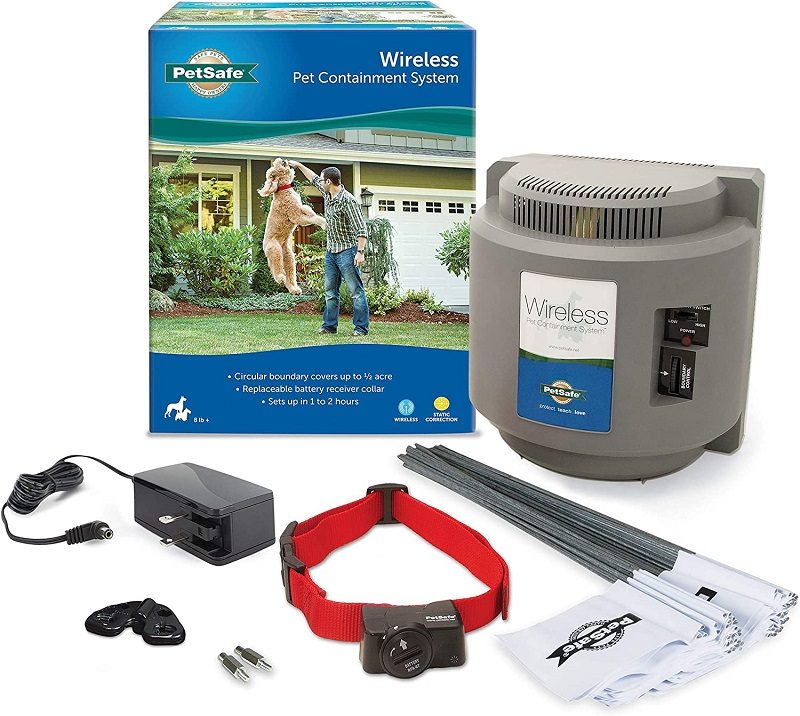
PetSafe Wireless Containment System
Our top wireless pick
It boasts great coverage area, relatively easy set up, a long battery life, and a portable system pet parents loved.
Without question, PetSafe and its parent company, Invisible Fence, have become leaders in the pet containment world. They have perfected safe, simple ways to keep your dog safe. And nowhere is that clearer than with the PetSafe Wireless Containment System.
This effective wireless fence system covers a lot of ground so your pet has plenty of space to play. Reviewers love the portable transmitter, steady signal, and comfortable, waterproof collar. Plus, the battery life is great on this wireless fence.
The set up is quite easy, just assemble and turn on the transmitter. This is one of the top benefits of a wireless system that’s not underground: set up will usually take an hour or so, rather than a few days.
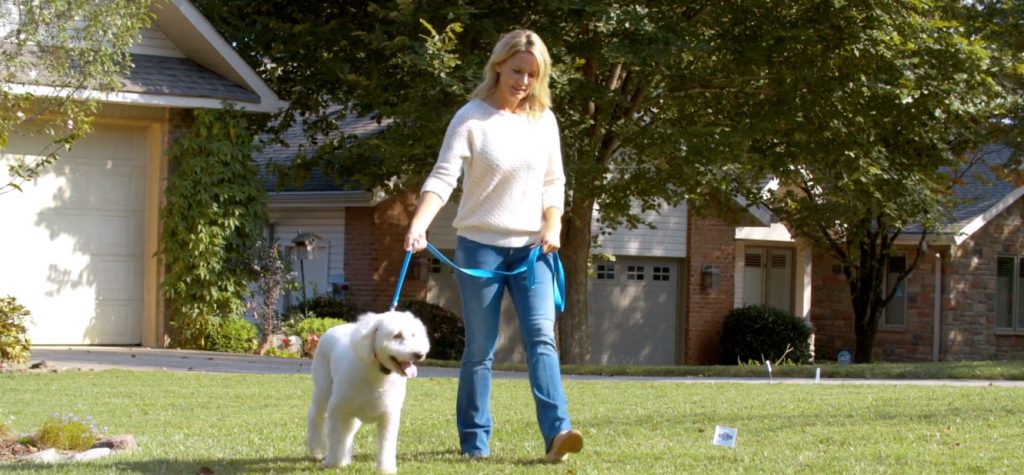
You can of course set flags at the limit of the range as a visual cue for your pet, but the collar also makes warning “beeps” that let your pup know they’re about to reach the limit, well before any shock happens. On the transmitter module you can set the the power of the shock and the distance.
Just be sure to very carefully follow the training protocol laid out in the instructions for best results.
Pros
- Great coverage area
- Easy set up
- Portable system
- Compatible with additional base units
- Comfortable, adjustable Collar
- Long battery life
Cons
- Signal quality decreases in hilly areas
- Battery charge decreases with recharges
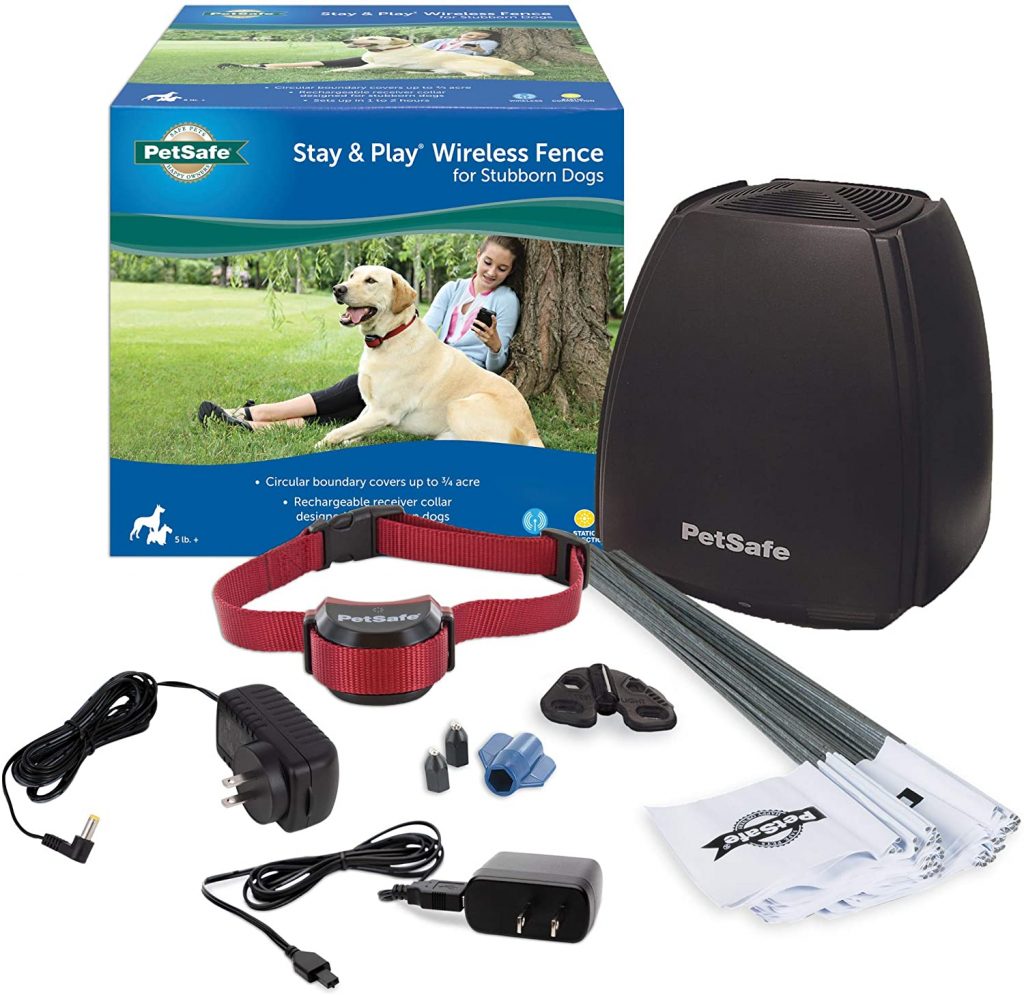
PetSafe Stay & Play Wireless Fence
Best for second choice
Great transmitter strength and not too overwhelming for smaller dogs.
It’s not at all surprising to see another PetSafe product on this list. The PetSafe Stay and Play covers more area and works on smaller pets than the Containment System above.
The Stay and Play wireless fence is known for being easy to adjust and to have a very strong transmitter. If you have a slightly larger property and a smaller dog, you might want to consider the Stay and Play system.
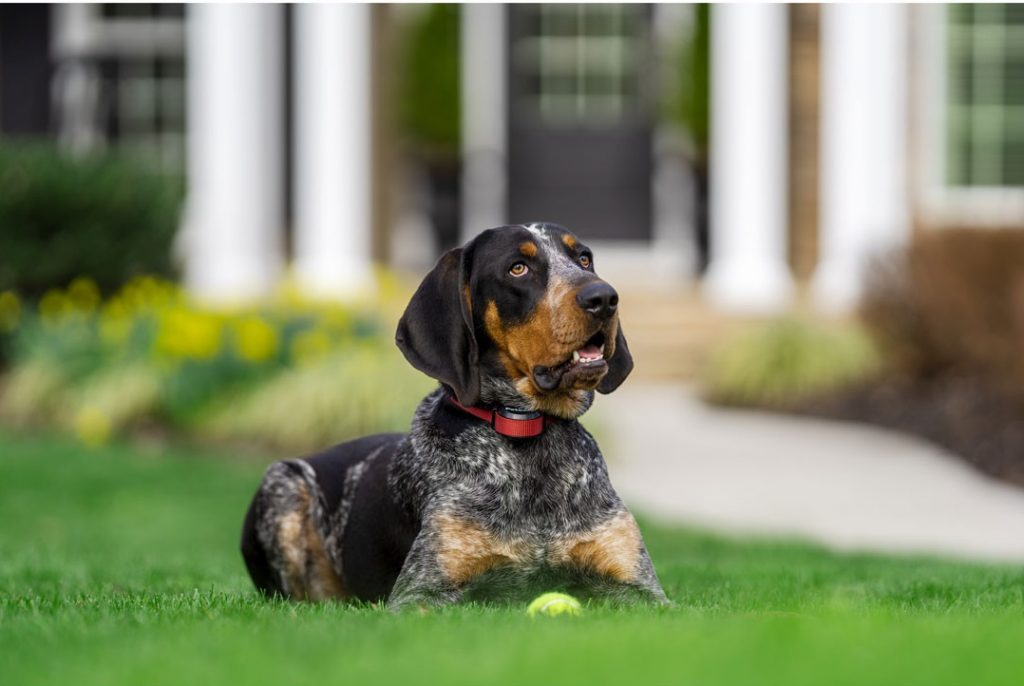
The collar is the standard two-prong, and the power button is placed on the inside, so your dog can’t accidentally turn it off by scratching or bumping against something. The Stay and Play is easily adjustable, so if your pup has anywhere from a 6-21″ neck, they’ll be well fit into the collar.
As a runner-up, PetSafe’s Stay and Play was a really close second. The collar hits almost all of our qualifications for the perfect wireless fence. And we’re not alone in our opinion! Dog owners have rated this system as one of their favorites, making it Amazon’s Choice for dog wireless fences. Overall, a really good pick.
Pros
- Easy to adjust
- Large coverage area
- Works with smaller dogs
- Waterproof
Cons
- Poor battery power
- Bulky collar for smaller dogs
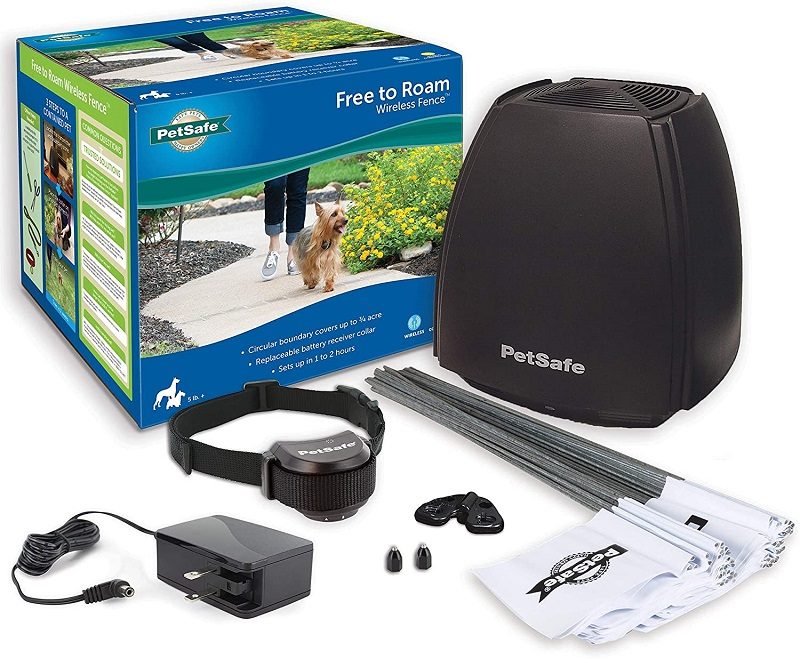
PetSafe Free to Roam Dog and Cat Wireless Fence
Best for small dogs
Because this works for both cats and dogs, it’s one of the most versatile fencing options on our list.
Are you starting to see a trend? Not only is PetSafe one of the best wireless dog fence companies, crafts some truly diverse systems.
The Free to Roam wireless system comes with PetSafe’s usual coverage area of a 3/4-acre, as well as 5 different correction levels. However, what makes this system stand out is its weight limits. The Free to Roam can be used by pets down to 5 pounds, making it a perfect option for small dogs or cats.
One of the best things about this wireless fence system is it has a sound-only training mode, for the more nervous pets. In addition, the transmitter is portable, perfect for camping trips or vacation homes!
Pros
- Long lasting battery
- Half an acre coverage
- Waterproof, adjustable collar
- Works for cats and dogs
Cons
- Field adjuster tricky
- Transmitter signal varies
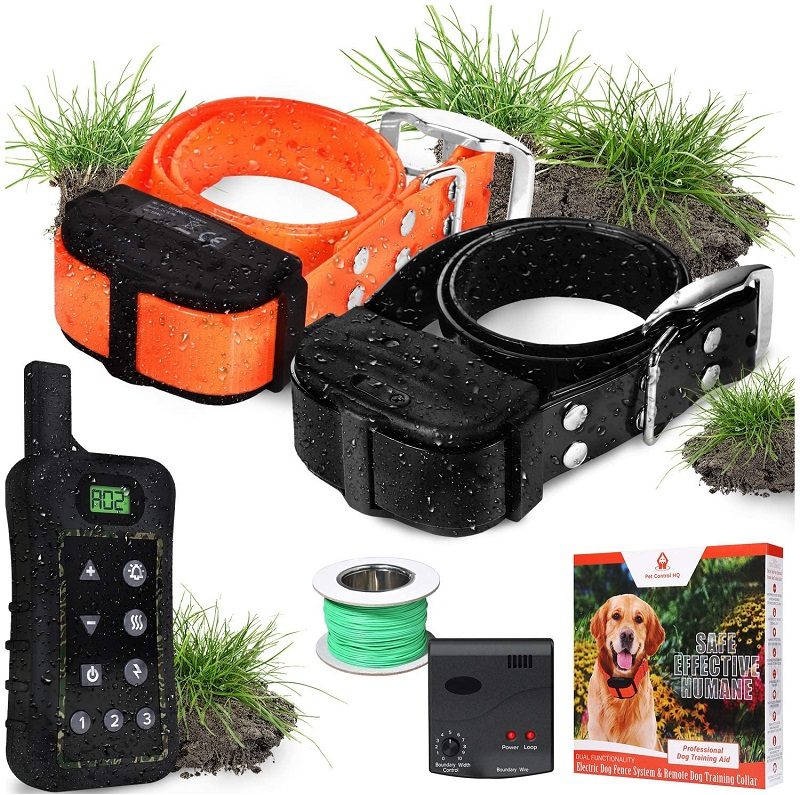
Pet Control HQ Wireless Combo Electric Dog Fence System
Best for large dogs
The dog fence comes with a portable, wireless transmitter as well as wire for you to set up an underground system.
You get the best of both worlds with the Pet Control HQ Wireless Combo system. If you aren’t sure if a wireless or underground system is best for you, the Pet Control HQ is a great place to start. This combo fence system comes with a variety of training levels, from beeping and vibrating to ten different static correction levels.
The Pet Control HQ can support up to 3 collars on one system. Plus, an extremely adjustable collar strap, which goes from 8 to 27 inches. While we wish the battery life was a bit longer, and didn’t take as long to charge, the number of collars and size of collars make this a fast favorite.
We’re also big fans of how the Pet Control HQ allows you to buy additional wires, collars, or even replacement remotes. Instead of having to replace the whole system if something goes wrong, this pick-what-you-need system is super helpful. They’ve also got great customer service if you have questions or need help with your system.
Pros
- Both wired and wireless
- Fantastic coverage
- Works for multiple dogs
- Money-back guarantee
- Varied beep, vibration, and Static modes
Cons
- Poor battery life
- Long charging times
- Wireless system covers less area than wired
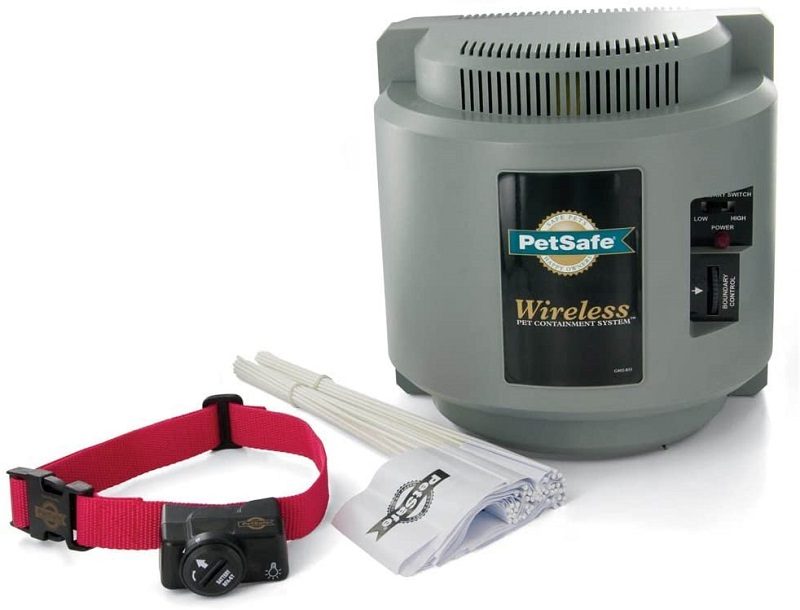
PetSafe PIF-300 Wireless 2-Dog Fence Containment System
Best for two dogs
This long-standing system has been adjusted over the years for great multi-pet support.
A powerful wireless fence containment system that was designed specifically for two dogs, PetSafe 2-Dog Fence is a great option for people with multiple pets.
We’re also big fans of the waterproof nature of the PetSafe PIF-300 collar. The collars can be used on dogs as small as 8 pounds and fits necks from 6 to 28 inches, perfect if you have 2 different sized dogs you want to train. The only issue with this system is it only covers a half-acre.
The PetSafe 2-Dog Fence Containment System has been around for a while, so it has been tweaked and adjusted to perfection. Covering a large area and producing a steady signal, the system comes with two comfortable, adjustable collars.
Pros
- Easy to install
- Comes with two collars
- Fits larger dogs
- Great battery life
Cons
- Expensive
- Only covers a half-acre
The top 5 in-ground fences
Now we’ll focus on the best in-ground, or underground, wire dog fences and share our top 5 choices.
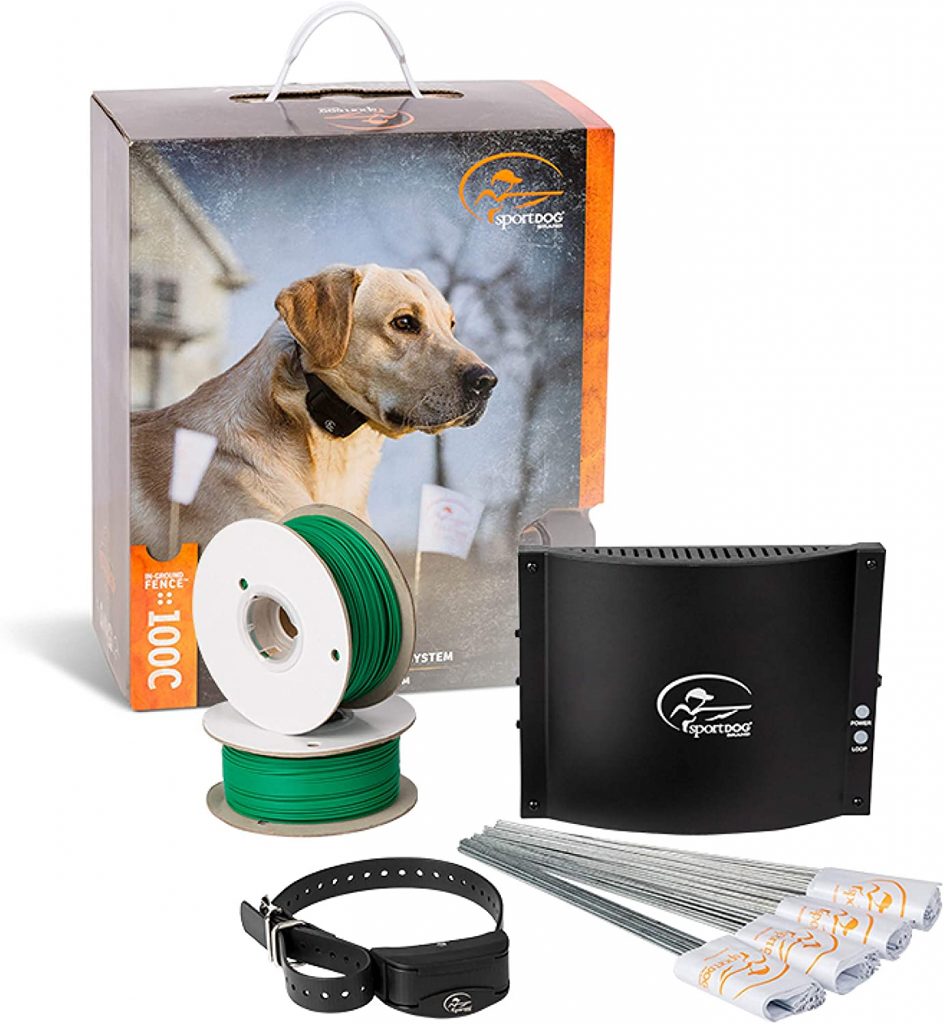
SportDOG Invisible Dog Fence System
Our top underground pick
The coverage and battery life of this system make it our top pick for a in-ground dog fence.
Our number one pick for underground systems, SportDog’s Invisible Fence System is one of the most comprehensive invisible fences available. With its waterproof, submersible collar, we love this system for active, adventurous dogs.
The collars included with the SportDOG are rechargeable, charging in 2 hours and holding the charge for up to 2 months. And the collars include a tone and a vibration option, so you don’t have to depend on the 7 static options.
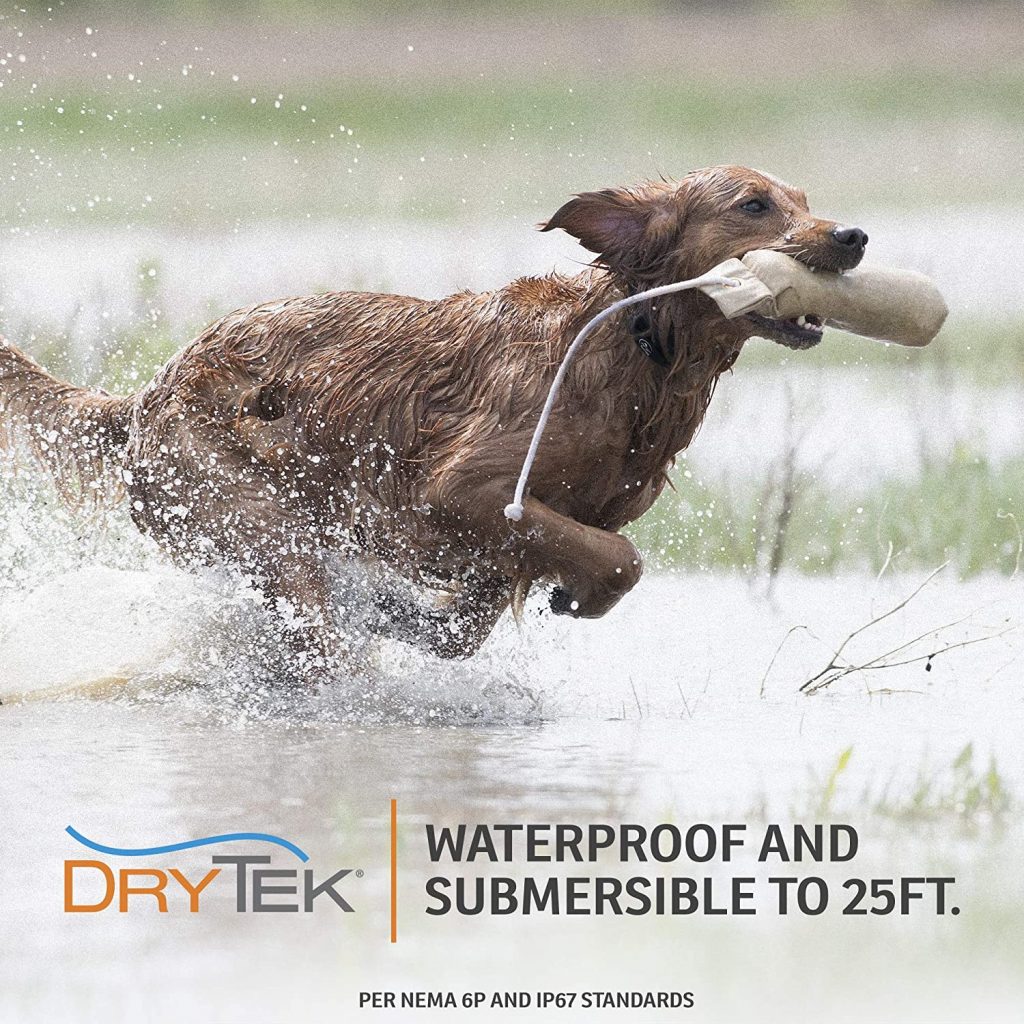
The containment system comes with all the parts you need to create a custom shaped, underground fence on your property. While this works best with medium-sized dogs, you can’t go wrong with this fencing system for almost all sized dogs. Plus, with the purchase of additional collars, you can add an unlimited number of dogs to this system.
The most impressive thing about this system is its ability to work at large distances — users report it working seamlessly even on a five acre plot. The top-level charge (setting 5) delivers a firm shock, meaning your dog will respect this collar (even if the power goes out or the battery dies). For those with larger properties, this is the ideal in-ground dog fence system.
Pros
- Covers huge area
- Can be expanded
- Waterproof, submersible collar
- Long battery life
- Wire breakage alarm
- Beeps and vibrates before static correction
Cons
- More expensive system
- Collar works best on medium or large dogs
- Extra collars are expensive
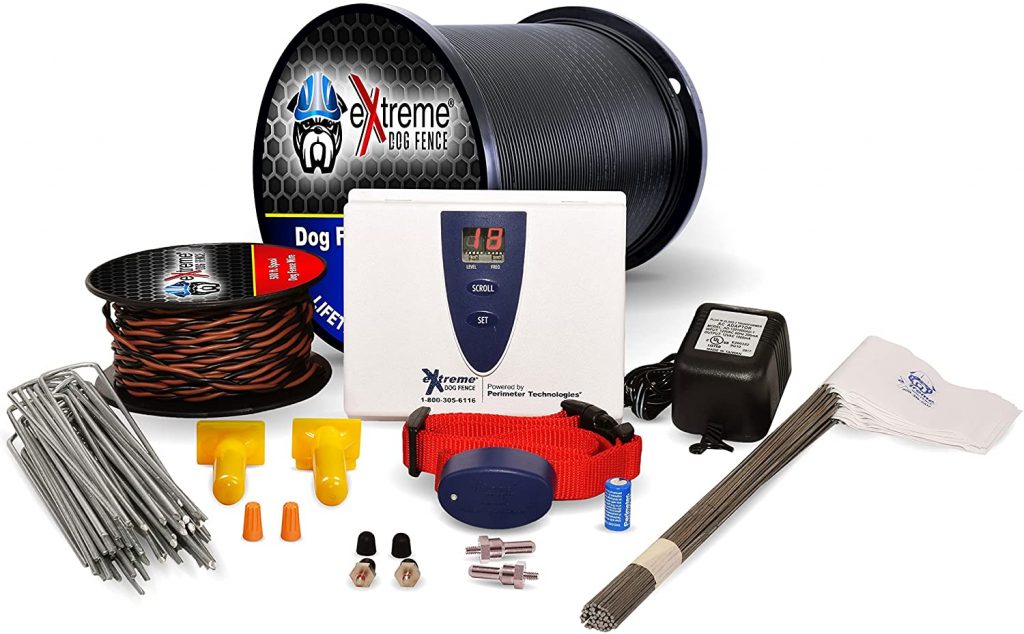
Extreme Dog Fence – Second Generation
Best for in-ground second choice
This is a tie with our best Underground option above. Consider this system instead if you have a large amount of space or your dog is a water-lover.
A very close second to the best for all underground systems, Extreme Dog Fence has a host of benefits. The high-quality underground fence system supports up to 5 dogs and can cover up to a whopping 10 acres with its 1,000′ option.
The quality of the fence kit for the Extreme Dog Fence is fantastic. The wire is 16 guage, making it thick and durable. If there is, for any reason, an issue with the fence, there is a 10 year warranty, which makes purchasing the system risk-free!
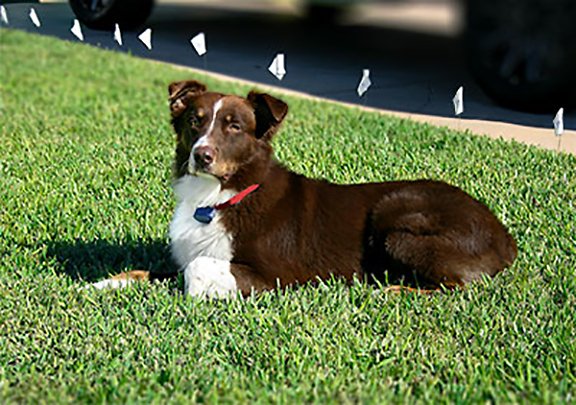
The fence system includes heavy duty wiring, an updated collar design, and a digital transmitter. If your pup is a water lover, this system has an added bonus of being submergible up to 10 feet.
What we really love here is the distance that’s safely covered, and the general robustness and toughness of the system overall. If your pup is rowdy and highly energetic, this is a great pick.
Pros
- Submergible collar
- System works for up to 5 dogs
- Heavy duty
- Covers up to 10 acres
Cons
- Time consuming to install
- Expensive
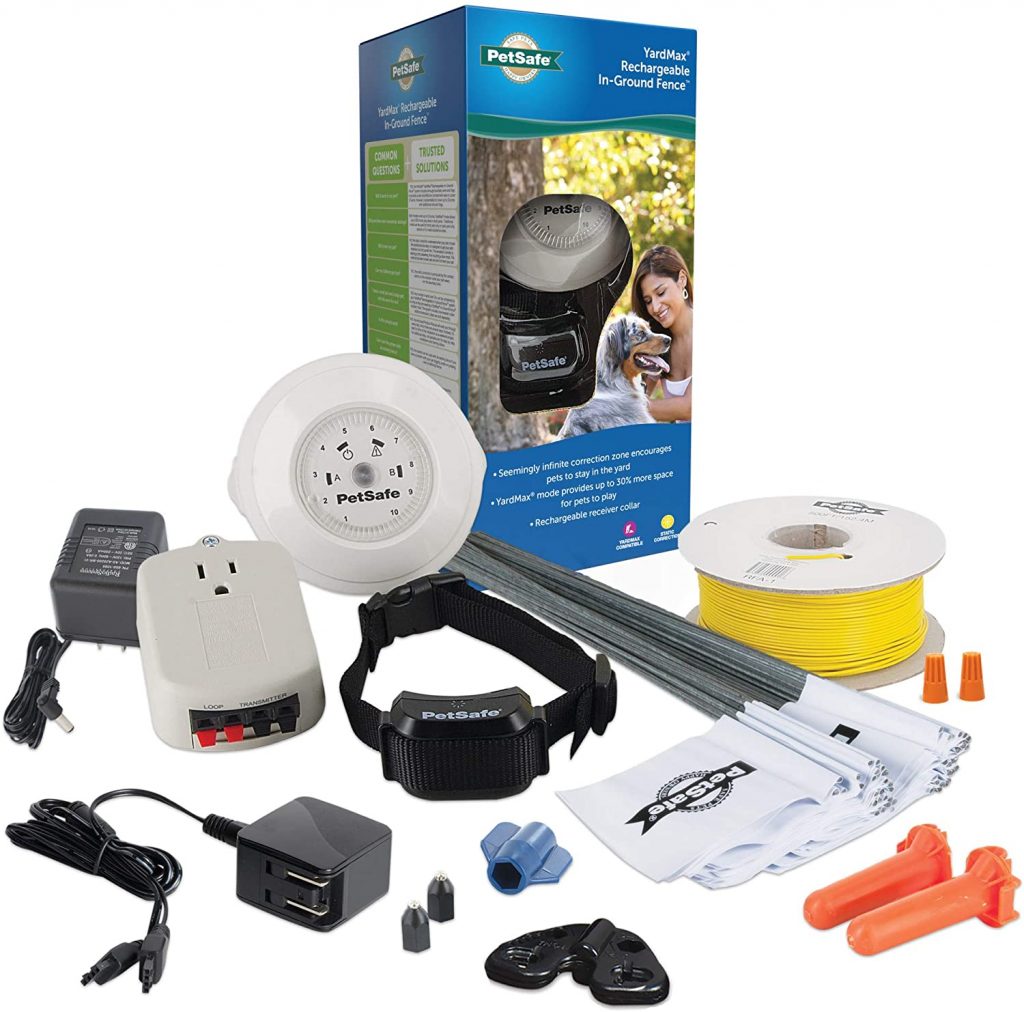
PetSafe YardMax Cordless In-Ground
Most versatile
Worth the price given how versatile it is and how you can replace the power source without using a proprietary battery.
The PetSafe YardMax is all about versatility. The underground fence can be used for small or large yards, one or a dozen dogs, and offers a variety of different training alerts.
While the PetSafe YardMax works great for larger areas, it really shines with smaller yards. With 500ft, you can have up to 1/3-acre in and ready to go over the weekend. And with 5 statice corrections, plus a ton-only mode, you can ease your pup into adjusting to the new system.
We love the variations offered by YardMax, including the fact that it can fit even the smallest of dogs. And we’re obviously fans of PetSafe and appreciate how well their products work together.
Pros
- Doesn’t require special batteries
- Coverage area can be expanded with additional wire
- Fits smaller dogs
- Static and tone corrections
Cons
- Expensive
- Starter kit only covers 1/3-acre
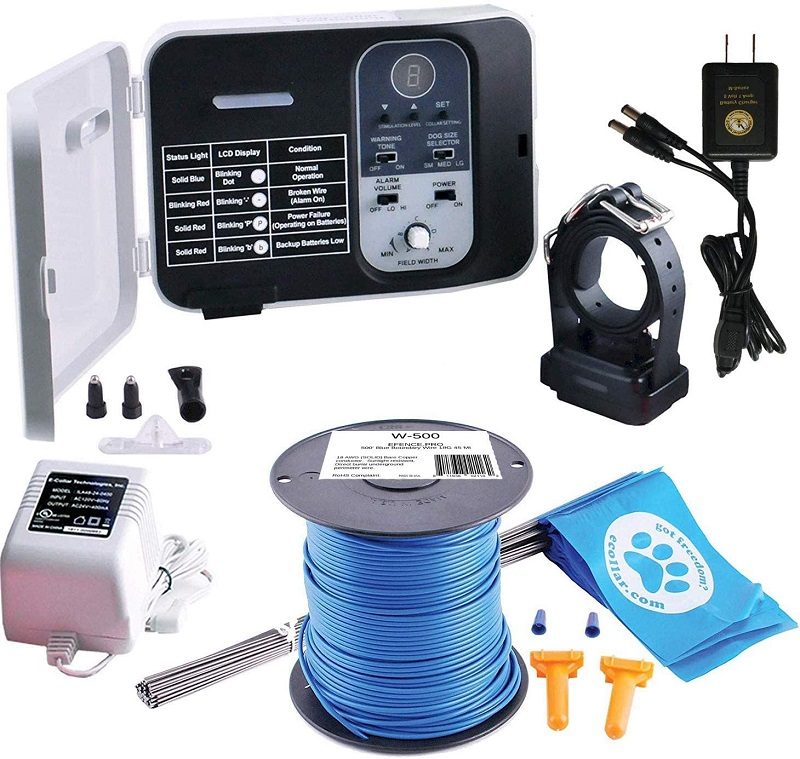
Educator E-Fence Underground Fence by E-Collar
Best for training
We like the tone-only option in this training fence.
As the name suggests, the Educator E-Fence is all about training dogs to stay within their set boundaries. Because education is at the forefront of this fence design, the collar comes with tone-only modes for the more nervous dogs in your life.
The Educator E-Fence is extremely user-friendly, with a cleanly designed transmitter and bright boundary flags that will catch the attention of even the most stubborn dogs. If you have multiple dogs, you can set the Educator E-Fence collars to personalized levels for each dog.
Pros
- Focused on training
- Run-through prevention
- Easy installation
Cons
- Cost adds up when full kit is purchased
- Purchasing options confusing – Make sure to Include Boundary Kit
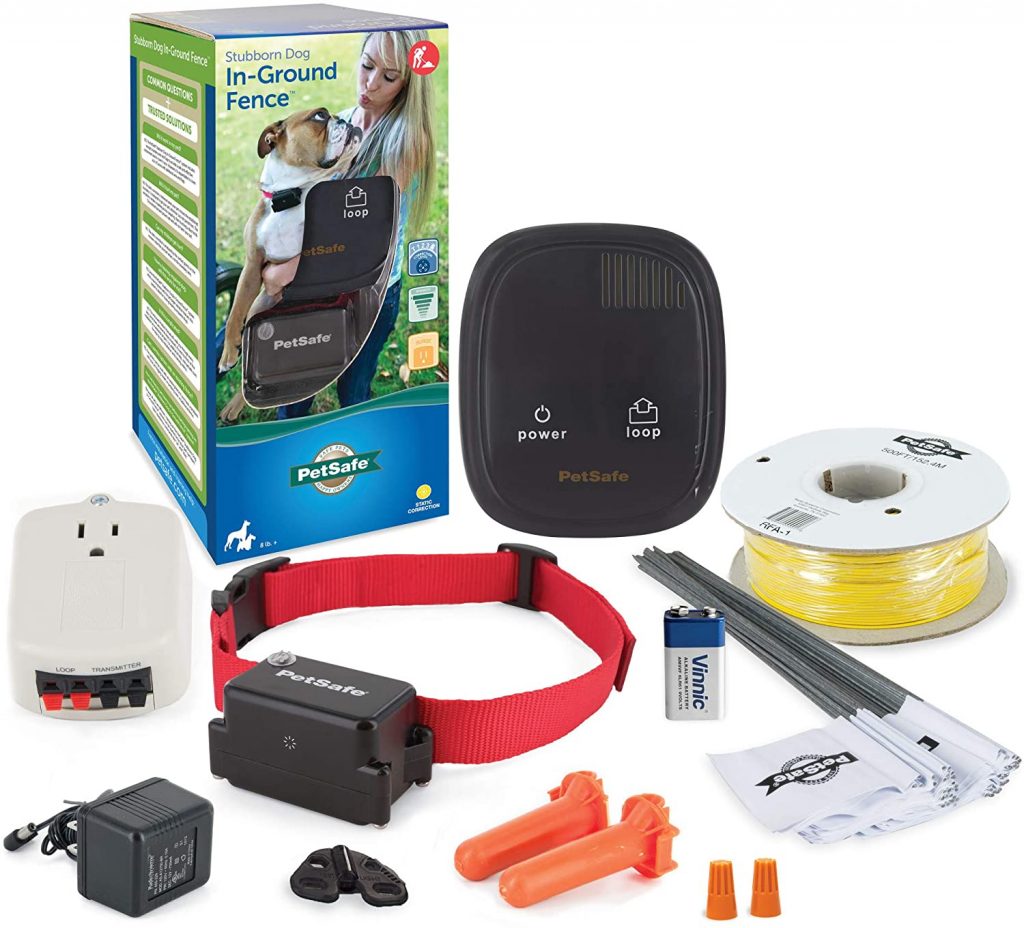
PetSafe Basic In-Ground Dog and Cat Fence
Best budget
Simple and cheap, this works for both cats and dogs, and has basic level-setting options.
We know dog people aren’t supposed to like cats and vice versa, but there are those of us who love all the pets! PetSafe has created this basic in-ground fence for those of us who have cats and dogs.
This barebones kit has adjustable collars that fit both cats and dogs. The collars come with four different levels of static correction, so you can keep your fur babies physically and emotionally safe.
Pros
- Inexpensive
- Great starter kit
- Works for cats and dogs
- Lightweight collar
Cons
- No buzz correction, just tone and static correction
- Long installation time
- Expensive to add extra wire
How does a wireless fence work?
Sometimes referred to as an invisible fence, a wireless pet fence is an electric boundary that keeps your dog within a certain space.

“A wireless dog fence is a great alternative to building a physical fence if finances, timing, or a renter’s contract won’t allow it. Using a wireless fence allows dogs safe access to the outdoors for exercise and fresh air without the worry of them running away or getting into trouble.”
Dr. Chyrle Bonk, DVM
There are two different types of invisible pet fences, a wireless fence and an underground fence. Both offer a boundary for your pet without you needing a visible fence or gate to keep your dog contained.
While the specifics of wireless and underground dog fences differ, they both have several similarities in how they work.

Both types of invisible pet fences will come with a collar for your pet. These dog collars will beep if your pet gets too close to the boundary. Then, if your sneaky doggo keeps approaching the boundary, a little static shock will be emitted from the collar. These basic concepts are the foundation for invisible dog fences.
The goal is to train a dog to stay within a certain boundary, allowing you to be worry free when your fur baby is outside.
How to pick the best dog fence for your needs
We can give you all the information in the world and it won’t mean anything if it doesn’t apply to you and your pup. So, in order for you to make the best choice for you and your pets, we turned to the experts.
Here are the top 5 considerations our partnered veterinarian, Dr. Chyrle Bonk, suggests you look for in a wireless pet fence.
The type of fence you want
The biggest question you’ll face when starting your search for an invisible pet fence is whether you want a wireless or wired system. Both have their benefits, but serve quite different purposes.
Wireless with a base station
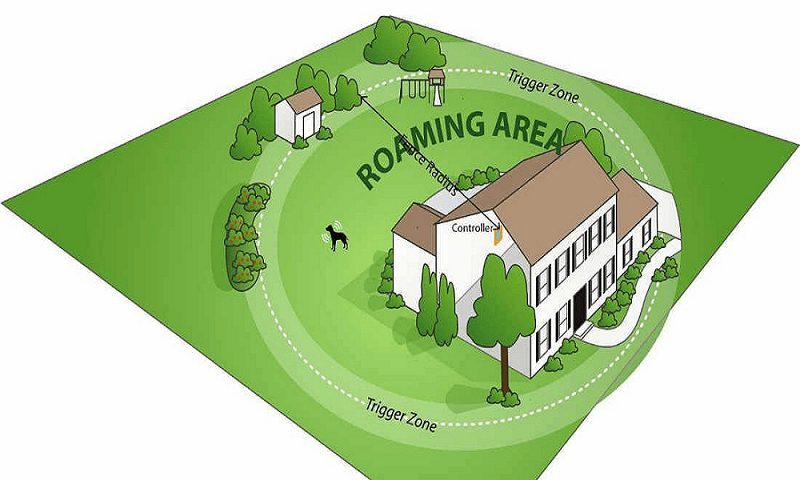
A signal is released by a base station for a set range. The signal is released in an exact circle and can get fuzzy around the boundary line, depending on the systems range capabilities. Perfect for those who want fast setup and an easy-to-move system.
In-ground wired fence

Wires are run from a main system and can be placed in any shape for as far as the wire reaches. Great for larger properties, awkward shaped yards, or those who want a permanent system in place. Does take more work to setup and might require digging up the yard.
We’ll go into much deeper detail in our All about the two types of dog fences section.
Size of your area
There are wireless and in-ground fence options for properties of all sizes. Most starting kits will have enough wiring or signal range, to cover an average-sized back yard.
However, if you have a larger yard or expansive property, you might need to get additional wiring or multiple ‘base camps’ to efficiently cover the area.
Before you start looking for an invisible dog fence, make sure you know the size of the area you’ll be using.
Warning and shock options
There are typically 3 warning options used by invisible dog fences.
Tone – A sharp beep that sounds when a dog is near the fence barrier or nearing the edge of range.
Vibration – A buzzing released by the collar when a dog is near the fence barrier.
Static correction – Sometimes called a ‘shock’, static corrections work just like tones or vibrations, but are much more startling.

Because you won’t know how your dog will respond to any of these, it’s best to find a collar that offers all 3 options. Also, the best invisible fence systems will have varying levels of static correction.
Multi-pet capabilities
If you have more than one dog, you don’t want to buy a system for each collar. The best systems will have the option to add more collars to the system.
Waterproofing
Dogs are notorious for being able to find that one muddy puddle in the yard. Due to this fantastic skill, you’ll want to look for a waterproof collar with your wireless fence system.
Bonus points if a system allows for a collar to be completely submerged. Double-check your wireless dog fence system for submerge times and depths.
Will a wireless fence work for my dog?
In general, and when training is done correctly, wireless fences work extremely well with most dogs. However, there will always be those outliers that will just not be able to adjust to using an invisible barrier.
There are two aspects you should consider when deciding whether a wireless fence will work for your dog or not: the size of your dog, and the personality of your dog.
Every dog has a personality and quirks of their own, which is why deciding on whether a wireless fence works will depend on the size and personality of your unique pet.

Size of your dog
First, most wireless fences will work for any size dog. The collars are also very versatile, so if you have a smaller or larger dog than average, you can find an option for that weight category. Some collars fit dogs as small as 5 pounds!
The versatility of these dog collars will keep your dog safe and comfortable. During the first few weeks of training your dog on the collar, you should closely monitor the fur and skin in contact with the collar. You want the collar to be snug enough that the static correction works, but not so tight that it chafes your pet’s neck.
To make sure you’re putting a collar on your dog properly, and getting the right size, check out this guide by PetMeds.
Personality of Your Dog
Just as important as making sure your dog is in a collar that fits is making sure this form of training will work for your dog. There are two ends of the spectrum for this: timid dogs and stubborn dogs.

Timid dogs might not respond well to the small shock that a wireless fence collar emits. Not only can it be scary for more nervous dogs, but if the training isn’t done right beforehand, they might not understand why they’re being punished.
Thankfully, most invisible dog fences offer collars that buzz or beep, as well as offer the small static correction. If a beep is all your dog needs to stay within their boundary, perfect! No need for the little shock.
Stubborn dogs will have just the opposite problem. If training isn’t done well and thoroughly with a stubborn dog, they’re more likely to flaunt the rules and become accustomed to running past the markers despite the shocks.
How to make sure your pet is safe using a wireless pet fence

The biggest question pet owners have when considering a wireless dog fence is if the collars are safe.
Always consult your vet, but in our experience as long as your dog has the right temperament and is healthy (not too young or too old) the “shock” of a shock collar will not do them any lasting damage. In fact, if you’re still worried once you’ve purchased a wireless fence, you can try the shock collar on yourself just to be certain.
Because a shock collar can cause a little friction around your dogs’ neck, as most collars do, it’s important to keep your pets necks clean. Also, keep an eye out for your dog rubbing on the collar or trying to get it off, as that can cause irritation in very rare instances.
The key to using a wireless fence safely is, of course, to make sure you follow all the instructions on the system you purchase. Different systems will have different setups, so read through those instructions carefully before training your dog.

Wireless vs. in-ground invisible dog fences – and which you should get!
There are two types of invisible dog barriers: Wireless and In-ground. Both serve specific purposes and can work well, depending on your needs. However, before you make a final decision on what’s right for you, a better overview of both is needed.
Let’s do a quick overview before we dive deeper into the differences between the two types of fences.
With a wireless fence, you’ll typically get a circular boundary a specific distance from a ‘basecamp’.
An in-ground fence can be customized into any shap, as long as it’s connected to a power source.
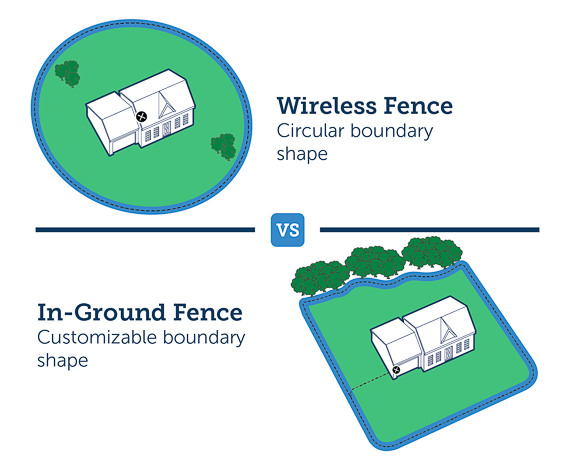
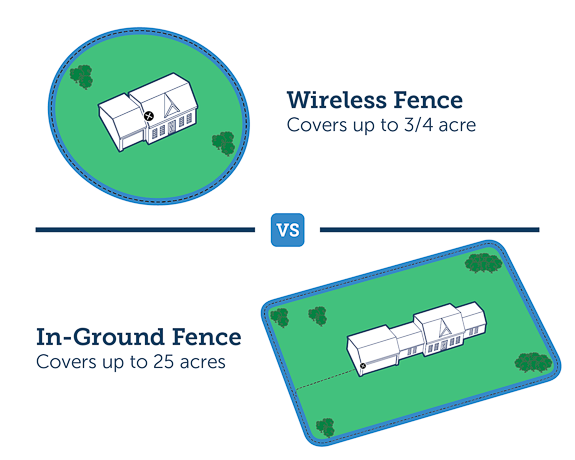
Due to the relieance of signal strength, wireless fences often cover less area than an in-ground fence, an average of 3/4 an acre.
An in-ground fence can cover acres worth of property, especially if the system allows additional wiring.
Wireless fences can be set up extremely fast. With a little tweaking and reading of the manual, you can be ready to go in a few hours.
In-ground fences can take days to install, especially if you have a large property.
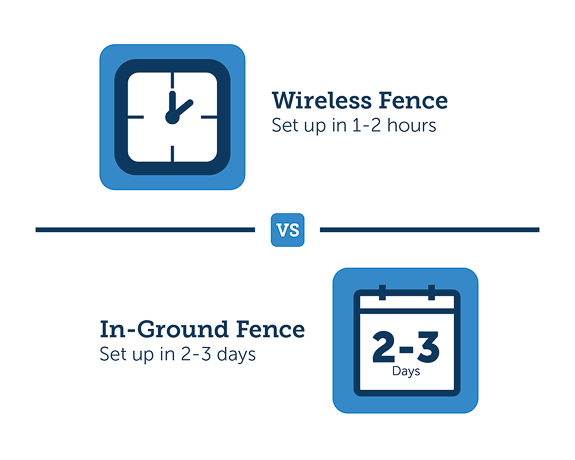
Now let’s take a deeper look at both and explore the pros and cons of wireless and in-ground dog fences.
Wireless fence with basecamp
A wireless with basecamp invisible dog fence uses a transmitter to cover a specified amount of space. The basecamp, or transmitter, is connected wirelessly to a collar and produce a shock whenever the collar crosses over the specified boundary.

We like wireless dog fences for homes with average-size yards where you’re trying to prevent your dog from running off. Because these fences only require a basecamp, you can also take it with you if you’re camping or need to move. As an added bonus, wireless dog fences are often cheaper than in-ground options.
The best wireless dog fences with basecamps are extremely easy to use, as they’re pretty much plug and go. However, there can be transmitter interference and sometimes the signal will fail. This type of fence typically works best in flat areas that aren’t too large, are flat, and have few obstructions.
Pros of wireless fences with basecamps
- Inexpensive
- Easy installation
- Moveable – Perfect for campers or renters
- No maintenance
Cons of wireless fences with basecamps
- Covers smaller areas
- Typically only allow circular containment areas
- Less dependable accuracy
- Heavier collars
- Possibility of signal disruption
In-ground wire fence

An underground wire dog fence, or in-ground fence, works similarly to a wireless fence, but instead of using a signal, these fences require the wire for the fence to be installed in the ground around a specific border.
Unlike wireless fences, underground fences can be made to the specific shape needed for a particular area. In fact, underground fences can even be used to keep pets out of certain areas, like a shed or a pond, instead of just keeping them contained in an area.
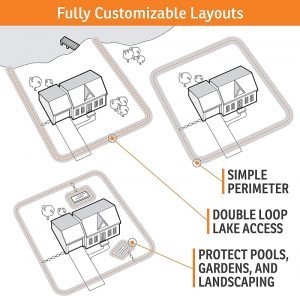
We highly recommend in-ground dog fences for larger properties where you might not be able to see your pet easily. Farms or larger yards really benefit from the size options of in-ground dog fences.
However, because underground fences need to be installed, they do take a little more effort. To be most effective, you’ll need to dig a shallow ditch where you want to install the wire, then recover it. The effort required to install underground fences is balanced by the accuracy and versatility of the boundaries.
Pros of underground wire fences
- Creates larger containment areas
- Customizable boundaries
- No signal interference
- Lighter collar
Cons of underground wire fences
- Expensive
- Installation requires digging and burying cables
- May require cable maintenance
- Difficult to transfer if you move
Our selection process – How we picked our top wireless dog fences
The health and well-being of all pets is paramount to us. As we researched invisible dog fences, we looked at specific standards in a variety of categories, all with the comfort and security of our pets in mind. And in an effort to be as transparent as possible, we like to share how we set our standards with you.
We have specific criteria to help us give you the best answer for which fences to choose for your dogs. Regardless of whether you use our recommendations, we believe these are the things you should research when purchasing a wireless electric fence.

Review & ratings
At the forefront of our research are the reviews and ratings for each wireless dog fence. To determine the list we’ve put together is of the highest quality, we read exhaustively through customer and trusted reviews for each product. We believe customers who have used these products on their precious furry friends have an insight into the quality of the systems. They, like you, want the best for their pets and will judge the systems accordingly.
In addition to reviews, we go over the safety history of the companies creating the dog fences. We want to make sure these companies not only take pet safety serious, but that their history speaks to that fact.
Cost
Even though we’d gladly give all the money in the world to keep our pets safe, most of us are on a budget when it comes to wireless dog fences. Whether you want a wireless dog fence system or an underground system, how much you’ll be paying is always going to be one of your biggest questions.
Therefore, one of our primary considerations when it comes to rating wireless dog fences is their cost and if that cost equals better quality. Just because it’s expensive, doesn’t mean it’s the best wireless dog fence available!

Coverage area
When considering coverage area, we examined how large an area each fence could protect. We also researched the quality of the coverage range, to make sure the transmitter strength matched the listed coverage size, to decrease false signals or loss of signal completely.
We looked at the adjustability of the coverage ranges, specifically with wireless dog fences. For the consideration of those with larger properties, we checked to see if the systems we researched allowed for multiple transmitters to increase coverage size without losing signal quality.
Collar specifications
Even though every aspect of a wireless dog fence needs to be of the highest quality, the collar is of particular importance. This is, after all, the device that will be in direct contact with your pet.
When examining the collars, we look at the compatibility of the collar with the weight and neck size of the dog. Because the thickness of dog hair can affect how well the collar looks, we also take note of the different types of dog hairs.

Similarly, every dog will react to collar correction differently, another criteria we consider is if there are options for different corrections. The best collars are those that offer warning tones or buzzes, as well as different levels of static correction intensity. As pet owners, it’s important to know if you can set these intensity levels manually or if they increase in automatic increments.
Other considerations we make are if the collar is waterproof or not, the battery life of the collar, and if the system can work with multiple collars on multiple dogs.
Why we care

We’re a pet care company operating in multiple cities and walking hundreds of dogs every day. We know what people are using at home (and we know what we like to use) to make sure all our pets are happy, safe, and comfy. We’ve got years of experience and thousands of dog walks and cat visits informing our every article.
Want more information?
Just ask us! Your PetsMaster is here to help. As an Amazon Associate, we earn from qualifying purchases.




We have 3 large dogs. One is about 180lbs. and 2 puppies that will be about 200 – 240lbs. Is there a system that is available for these size dogs?